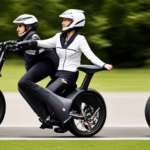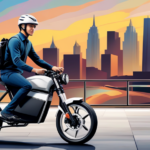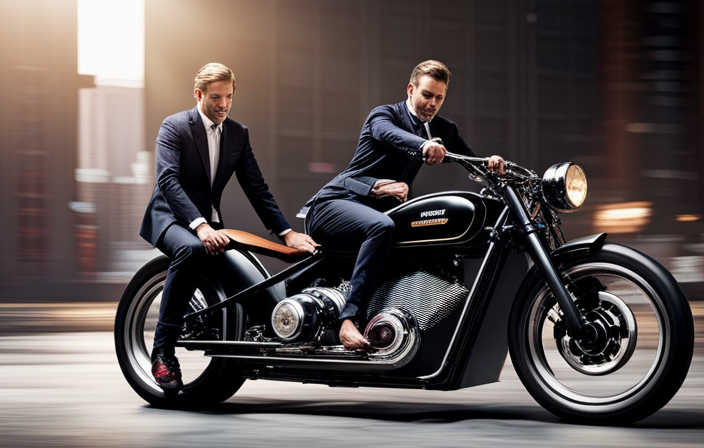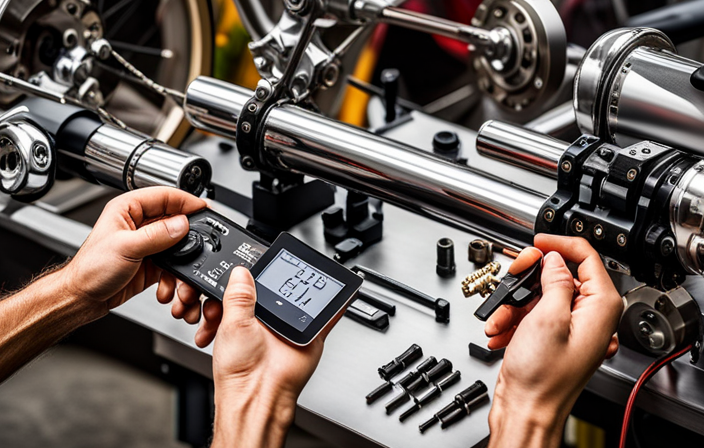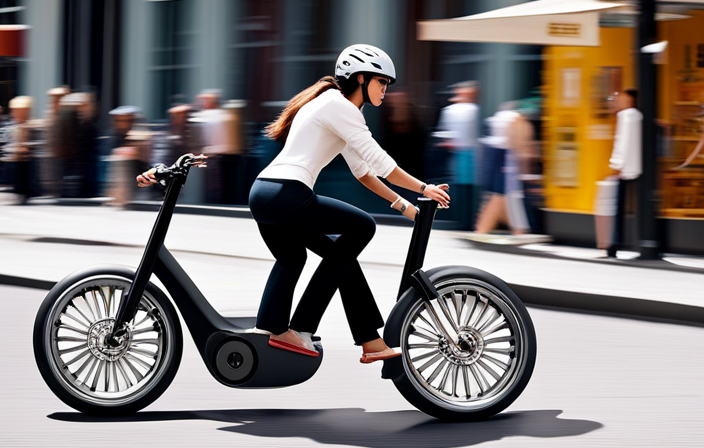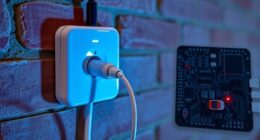Do you want to experience the exhilarating freedom of riding an electric bike? Get ready to soar through the streets like a lightning bolt!
In this article, we will guide you through the intricate process of operating an electric bike. From familiarizing yourself with the controls to mastering the art of navigating hills, we’ve got you covered.
So, strap on your helmet and get ready for an electrifying adventure on two wheels!
Key Takeaways
- Navigating hills and inclines: Maintain a steady speed, distribute weight evenly, shift into a lower gear, maintain a consistent cadence, and shift body weight slightly forward for better traction.
- Descending hills: Shift into a higher gear, control speed, use both brakes evenly, avoid excessive squeezing, and practice techniques for confident navigation.
- Practice safe riding habits: Wear a helmet and reflective gear, take precautions for higher speeds, obey traffic laws, be visible with bright clothing and reflective gear, and stay alert while anticipating hazards.
- Perform regular maintenance: Check tire pressure regularly, adjust as needed, inspect brakes for proper functioning, replace worn brake pads promptly, lubricate chain and gears for efficiency, monitor battery charge, and regularly inspect bike components for wear or damage.
Familiarize Yourself with the Controls and Display
First, you’ll want to familiarize yourself with the controls and display of your electric bike. The controls are typically located on the handlebars and consist of a throttle, brakes, and a control panel. The throttle is used to accelerate the bike, while the brakes allow you to slow down or stop.
The control panel displays important information such as battery level, speed, and assist level. It may also have buttons to adjust the assist level or turn on the lights. To navigate the display, you usually have to press or hold certain buttons.
Once you are comfortable with the controls and display, you can easily move on to the next section about turning the electric bike on and off.
Turn the Electric Bike On and Off
To start and stop the electric bike, simply press the power button located on the handlebar. This button is usually labeled with a power symbol, such as a circle with a line through it. When you press the power button, the electric bike will turn on and you will see the display come to life. The display provides important information such as speed, battery level, and power assist level. It may also have additional features like a trip meter or a backlight for nighttime riding. Take a moment to familiarize yourself with the display and its functions before you start riding. Once the electric bike is powered on, you can adjust the power assist level to customize your riding experience.
| Power Assist Level | Description | Recommended Use |
|---|---|---|
| Eco | Minimal assistance, conserves battery | Ideal for longer rides or when you want to pedal mostly on your own |
| Normal | Balanced assistance, suitable for most riding | Great for everyday commuting or recreational riding |
| Sport | Maximum assistance, boosts your speed and power | Perfect for hilly terrain or when you need an extra boost |
| Off | No assistance, relies solely on your pedaling power | Use when you want a more traditional biking experience or to conserve battery life |
Now that you know how to turn the electric bike on and off, let’s explore how to adjust the power assist level for an optimized riding experience.
Adjust the Power Assist Level
Once the electric bike is powered on, you can easily customize your riding experience by adjusting the power assist level. This feature allows you to control the amount of assistance the motor provides while pedaling.
Here are three ways you can adjust the power assist level:
-
Use the control panel: Most electric bikes have a control panel on the handlebars. Simply press the up or down buttons to increase or decrease the power assist level.
-
Use the mobile app: Some electric bikes come with a companion mobile app that allows you to connect your phone to the bike via Bluetooth. Through the app, you can adjust the power assist level and access other advanced settings.
-
Use the on-board display: Certain models have an on-board display that lets you change the power assist level directly on the bike.
By adjusting the power assist level, you can tailor the riding experience to your preference, whether you want more assistance on uphill climbs or a more challenging workout.
Now that you know how to adjust the power assist level, let’s move on to starting and stopping safely.
Start and Stop Safely
When starting and stopping, make sure to maintain a firm grip on the handlebars and apply gentle pressure to the brakes. This will ensure a safe and controlled operation of your electric bike.
Before starting, it is important to familiarize yourself with the controls and features of the bike. Once you are ready to start, simply turn on the power and gently pedal to engage the motor.
When stopping, smoothly release the pedals and gradually apply the brakes to bring the bike to a complete halt. It is also essential to be aware of your surroundings and use hand signals when turning or changing lanes.
Understanding the different riding modes available on your electric bike will allow you to customize your riding experience to suit your needs.
Transitioning into the next section, let’s explore how to understand the different riding modes.
Understand the Different Riding Modes
Understanding the different riding modes on your e-bike allows you to customize your experience.
Most electric bikes come with multiple riding modes that provide various levels of assistance and control. The most common modes include Eco, Normal, and Sport.
In Eco mode, the motor provides the least amount of assistance, which helps conserve battery power and extends your range.
Normal mode offers a balanced level of assistance, suitable for everyday riding.
And in Sport mode, the motor provides maximum power and acceleration for a more thrilling ride.
To switch between these modes, simply use the control panel or buttons on your e-bike’s handlebars.
Now that you understand the different riding modes, let’s move on to how you can maintain the battery life of your e-bike.
Maintain the Battery Life
To maximize your battery life, it’s important to follow a few simple maintenance tips.
First, make sure to keep your battery charged between 20% and 80%. Avoid fully draining or overcharging it, as this can shorten its lifespan.
Additionally, store your electric bike in a cool and dry place, away from extreme temperatures and moisture. Regularly clean the battery and its connectors with a soft cloth to prevent any dirt or debris from affecting its performance.
Finally, when not using your electric bike for an extended period, keep the battery at around 50% charge. By following these maintenance tips, you can ensure your battery lasts longer and provides optimal performance.
Now, let’s move on to learning proper braking techniques.
Learn Proper Braking Techniques
Learning proper braking techniques is essential for safe and effective riding. When operating an electric bike, you must understand how to control your speed and come to a stop efficiently.
To start, familiarize yourself with the different types of brakes on your bike, such as disc brakes or rim brakes. As you ride, always keep your fingers on the brake levers, ready to engage them when needed. When braking, apply even pressure to both brakes to maintain stability and prevent skidding. Remember to adjust your braking force based on the road conditions and the weight of your bike.
Navigate Hills and Inclines
When navigating hills and inclines, it’s important to maintain a steady speed and distribute your weight evenly on the bike. To tackle uphill climbs smoothly, shift into a lower gear to make pedaling easier. Try to maintain a consistent cadence to prevent straining your muscles.
As you approach the hill, shift your body weight slightly forward to keep the front wheel grounded. This will provide better traction and control. Keep your eyes focused on the road ahead and choose the best line to follow.
When descending, shift into a higher gear to control your speed. Remember to use both brakes evenly and avoid excessive squeezing. By practicing these techniques, you’ll be able to navigate hills and inclines with confidence.
Now, let’s move on to the next section about practicing safe riding habits.
Practice Safe Riding Habits
Remember the importance of wearing a helmet and reflective gear while riding to ensure your safety. Electric bikes can reach higher speeds than traditional bicycles, so it’s crucial to take precautions. Additionally, practicing safe riding habits is essential to avoid accidents and injuries. Here are some key safety tips to keep in mind:
| Safety Tip | Explanation |
|---|---|
| Obey traffic laws | Follow all traffic signals and signs, just like you would while driving a car. |
| Be visible | Wear bright clothing and use reflective gear to increase your visibility, especially during low light conditions. |
| Stay alert | Pay attention to your surroundings and anticipate any potential hazards. |
| Signal your intentions | Use hand signals to indicate your turns or lane changes to other road users. |
| Ride in designated areas | Stick to bike lanes and paths whenever possible to minimize interactions with vehicles. |
Perform Regular Maintenance and Inspections
Now that you are familiar with safe riding habits, it is crucial to understand the importance of performing regular maintenance and inspections on your electric bike. By doing so, you can ensure the bike’s optimal performance and extend its lifespan.
Start by regularly checking the tire pressure and adjusting it as needed. Inspect the brakes to ensure they are functioning properly and replace worn brake pads promptly.
Lubricate the chain and gears regularly to minimize friction and maximize efficiency. Keep an eye on the battery’s charge level and recharge it as needed, following the manufacturer’s guidelines.
Additionally, inspect the frame, handlebars, and pedals for any signs of wear or damage. By conducting these routine inspections and maintenance tasks, you can enjoy a safe and reliable electric biking experience.
Conclusion
In conclusion, operating an electric bike is a breeze once you get the hang of it. By familiarizing yourself with the controls and display, adjusting the power assist level, and understanding the different riding modes, you’ll be cruising smoothly in no time.
Remember to practice safe riding habits, navigate hills and inclines with ease, and perform regular maintenance and inspections to ensure a long-lasting ride.
So, hop on your electric bike, hit the road, and let the wind be your guide. It’s time to pedal to the metal!


